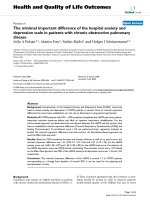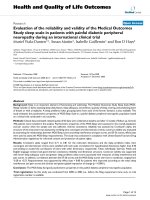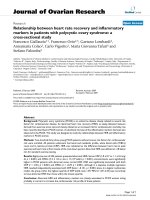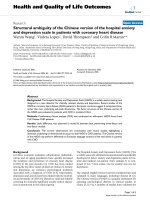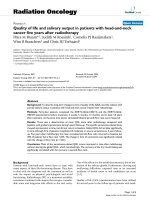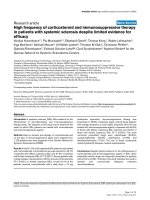The association between dose of clozapine and panss scale in patients with schizophrenia poorly responsive to classic neuroleptiques
Bạn đang xem bản rút gọn của tài liệu. Xem và tải ngay bản đầy đủ của tài liệu tại đây (96.62 KB, 7 trang )
Journal of military pharmaco-medicine no7-2018
THE ASSOCIATION BETWEEN DOSE OF CLOZAPINE AND
PANSS SCALE IN PATIENTS WITH SCHIZOPHRENIA
POORLY RESPONSIVE TO CLASSIC NEUROLEPTIQUES
Phung Thanh Hai*; Bui Quang Huy**; Cao Tien Duc**
SUMMARY
Objectives: To evaluate the treatment result of clozapine in schizophrenic patients respond
poorly to classic neuroleptiques. Subjects and methods: A prospective, cross-sectional, caseby-case analysis on 61 schizophrenic inpatients who responded poorly to classic haloperidol,
aged 16 to 55 years and received treatment at National Psychiatric Hospital No 1 between 2014
and 2017. The data were processed by medical statistics using program SPSS Version 17.
Result: PANSS scores were significantly different before and after clozapine treatment. Scores
of P-PANSS, N-PANSS, G-PANSS and S-PANSS at three surveys were different with statistical
significance. Haloperidol and clozapine had a positive correlation but very weak between dose
and plasma levels. Conclusion: PANSS scores in patients with schizophrenia, who responded
poorly to haloperidol, were significantly different before and after clozapine treatment.
* Keywords: Schizophrenia; Classic neuroleptiques; Clozapine; PANSS scale.
INTRODUCTION
Schizophrenia is a group of severely
psychotic disorders. The incidence of
schizophrenia ranged from 0.3 to 1.5% of
the population. Approximately 30 - 40% of
patients with schizophrenia respond poorly
or do not respond to classic neuroleptique.
Symptoms in these patients did not
improve after 4 weeks of treatment with
classic antipsychotics. These patients must
be treated with clozapine.
Sadock B.J (2015) argues that there is
a strong correlation between dose of
clozapine and therapeutic efficacy [4].
Therefore, dose of clozapine should be
carefully monitored so that dosages can
be adjusted to improve therapeutic efficacy.
In Vietnam, there haven’t even been any
studies on the association between dose
of clozapine and the results of treatment
of schizophrenic patients who respond
poorly to classic antipsychotics. We
aimed: To evaluate the treatment results of
clozapine in schizophrenic patients responding
poorly to classic neuroleptiques.
SUBJECTS AND METHODS
The study included 61 schizophrenic
inpatients, aged 16 - 55 years, who was
received treatment at National Psychiatric
Hospital No 1 between 2014 and 2017.
* National Psychiatric Hospital No 1
** 103 Military Hospital
Corresponding author: Phung Thanh Hai ()
Date received: 11/04/2018
Date accepted: 31/08/2018
151
Journal of military pharmaco-medicine no7-2018
Patients were treated for the first
4 weeks with adequate dose of
haloperidol but they improved less
than 20% of PANSS score. Then, the
patients were treated with clozapine.
The results were collected at the time
of three
30 days.
months,
separated
by
Use method of prospective, crosssectional, case-by-case analysis. The
data were processed by medical statistics
using program SPSS version 17.
RESULTS
Table 1: Relationship between dose of clozapine and PANSS score.
Dose
PANSS score
Dose of clozapine (mg/day)
(n = 61)
Time 2
(228.69 ± 48.48)
p2-3
p2-4
Time 3
Time 4
(228.69 ± 48.48) (228.69 ± 48.48)
∑ PANSS total
score
134.23 ± 5.68
87.21 ± 3.65
64.59 ± 2.88
p < 0.001
p < 0.001
∑ P-PANSS
27.11 ± 4.24
13.62 ± 1.47
12.52 ± 1.29
p < 0.001
p < 0.001
∑ N-PANSS
29.25 ± 1.90
26.97 ± 2.07
14.20 ± 1.60
p < 0.001
p < 0.001
∑ G-PANSS
64.64 ± 2.87
40.38 ± 2.15
31.87 ± 1.87
p < 0.001
p < 0.001
∑ S-PANSS
13.23 ± 1.12
6.25 ± 0.72
6.00 ± 0.00
p < 0.001
p < 0.001
∑ Anergia
9.38 ± 1.82
7.47 ± 1.26
6.52 ± 0.81
p < 0.001
p < 0.001
∑ Thought
disturbance
15.13 ± 1.92
8.03 ± 0.94
7.26 ± 0.73
p < 0.001
p < 0.001
∑ Activation
12.72 ± 0.95
6.49 ± 0.62
5.84 ± 0.37
p < 0.001
p < 0.001
∑ Paranoid bellig
13.59 ± 1.28
6.59 ± 0.82
5.85 ± 0.36
p < 0.001
p < 0.001
∑ Depression
12.54 ± 1.18
8.59 ± 1.19
7.82 ± 0.56
p < 0.001
p < 0.001
The association between the dose of
clozapine and the PANSS scale in patients
with schizophrenia showed that the all
respondents were significantly different in
the three surveys with p < 0.001.
Varuni D.S and Raveen H (2010)
studied 67 schizophrenic patients, who
were started with clozapine due to
resistance to at least two other
antipsychotics. Although a minimum daily
dose of 200 mg is recommended for
clozapine, 12 patients (17.9%) were on a
152
daily dose of 200 mg/day while 5 were on
150 mg/day. Of the sample, 43.3% were
on 225 - 400 mg/day. Only 3 patients
were on more than 600 mg/day.
Mohammad S (2005) studied on
11 schizophrenic patients, who was
received treatments with clozapine. Before
treatment, the total PANSS score was
235, and after treatment it decreased to
123 (p < 0.0001); t = -7.83.
Our results are consistent with the
above authors.
Journal of military pharmaco-medicine no7-2018
Table 2: Relationship between dose of clozapine and P-PANSS score.
Dose
Dose of clozapine (mg/day)
(n = 61)
p2-3
p2-4
1.18 ± 0.39
p < 0.001
p < 0.001
2.46 ± 0.53
1.98 ± 0.13
p < 0.001
p < 0.001
2.98 ± 1.87
1.52 ± 0.50
1.20 ± 0.40
p < 0.001
p < 0.001
P4 Excitement
4.20 ± 0.51
2.05 ± 0.28
1.84 ± 0.37
p < 0.001
p < 0.001
P5 Grandiosity
3.69 ± 0.50
1.75 ± 0.47
1.36 ± 0.48
p < 0.001
p < 0.001
P6 Suspiciousness
4.72 ± 0.80
2.13 ± 0.34
1.88 ± 0.32
p < 0.001
p < 0.001
P7 Hostility
4.44 ± 0.59
2.15 ± 0.40
1.98 ± 0.13
p < 0.001
p < 0.001
Time 2
(228.69 ± 48.48)
Time 3
(228.69 ± 48.48)
Time 4
(228.69 ± 48.48)
P1 Delusions
3.11 ± 1.97
1.56 ± 0.50
P2 Conceptual
disorganization
3.97 ± 0.89
P3 Hallucinations
P-PANSS
There was a significant difference in P-PANSS among the three surveys with p <
0.001. According to Mohammad S (2005), P-PANSS pre-treatment was 34 ± 8.81 and
after 3 months treatment, this figure was 17 ± 3.76. Our results were consistent with
the Mohammad S.
Table 3: Relationship between dose of clozapine and N-PANSS score.
Dose
Dose of clozapine (mg/day)
(n = 61)
p2-3
p2-4
1.33 ± 0.47
p < 0.001
p < 0.001
4.21 ± 0.66
2.02 ± 0.13
p < 0.001
p < 0.001
4.62 ± 0.49
4.31 ± 0.59
2.02 ± 0.13
p < 0.001
p < 0.001
N4 Passive/
apathetic social
withdrawal
4.84 ± 0.61
4.44 ± 0.53
2.23 ± 0.42
p < 0.001
p < 0.001
N5 Difficulty in
abstract thinking
4.82 ± 0.39
4.47 ± 0.57
2.28 ± 0.45
p < 0.001
p < 0.001
N6 Lack of
spontaneity and flow
of conversation
4.56 ± 0.53
3.95 ± 0.28
2.33 ± 0.47
p < 0.001
p < 0.001
N7 Stereotyped
thinking
4.18 ± 0.46
3.70 ± 0.49
2.00 ± 0.00
p < 0.001
p < 0.001
Time 2
Time 3
Time 4
(228.69 ± 48.48)
(228.69 ± 48.48)
(228.69 ± 48.48)
N1 Blunted affect
1.51 ± 0.81
1.87 ± 1.28
N2 Emotional
withdrawal
4.72 ± 0.55
N3 Poor rapport
N-PANSS
The three surveys of N-PANSS were very diverse. N2, N3, N5, N6 and N7 were
statistically significant differences with p < 0.001. From the study by Mohammad S
153
Journal of military pharmaco-medicine no7-2018
(2005), N-PANSS pre-treatment was 34.45 ± 8.8 and after 3 months treatment was
18.45 ± 5.62. Our results were consistent with the Mohammad S.
Table 4: Relationship between dose of clozapine and G-PANSS.
Dose
Dose of clozapine (mg/day)
(n = 61)
p2-3
p
Time 2
Time 3
Time 4
(228.69 ± 48.48)
(228.69 ± 48.48)
(228.69 ± 48.48)
G1 Somatic concern
3.84 ± 0.66
3.39 ± 0.56
1.97 ± 0.36
p < 0.001 p < 0.001
G2 Anxiety
3.92 ± 0.59
3.38 ± 0.61
1.90 ± 0.30
p < 0.001 p < 0.001
G3 Guilty feelings
3.77 ± 0.50
4.31 ± 0.59
1.97 ± 0.18
p < 0.001 p < 0.001
G4 Tension
4.69 ± 0.53
2.85 ± 0.44
2.00 ± 0.00
p < 0.001 p < 0.001
G5 Mannerisms and
posturing
3.84 ± 0.37
2.95 ± 0.22
2.00 ± 0.00
p < 0.001 p < 0.001
G6 Depression
3.87 ± 0.34
2.93 ± 0.36
1.98 ± 0.13
p < 0.001 p < 0.001
G7 Motor retardation
3.93 ± 0.31
2.29 ± 0.49
2.18 ± 0.43
p < 0.001 p < 0.001
G8 Uncooperativeness
4.43 ± 0.56
2.31 ± 0.50
1.98 ± 0.13
p < 0.001 p < 0.001
G9 Unusual thought
content
4.49 ± 0.50
2.34 ± 0.48
2.00 ± 0.00
p < 0.001 p < 0.001
G10 Disorientation
1.00 ± 0.00
1.00 ± 0.00
1.00 ± 0.00
p < 0.001 p < 0.001
G11 Poor attention
4.57 ± 0.49
2.47 ± 0.50
2.33 ± 0.47
p < 0.001 p < 0.001
G12 Lack of judgment
and insight
4.64 ± 0.52
2.74 ± 0.44
2.28 ± 0.45
p < 0.001 p < 0.001
G13 Disturbance of
volition
4.28 ± 0.58
2.11 ± 0.32
2.00 ± 0.00
p < 0.001 p < 0.001
G14 Poor impulse
control
4.82 ± 0.39
2.08 ± 0.28
2.03 ± 0.18
p < 0.001 p < 0.001
G15 Preoccupation
3.74 ± 0.44
2.16 ± 0.37
2.00 ± 0.00
p < 0.001 p < 0.001
G16 Active social
avoidance
4.82 ± 0.39
2.51 ± 0.54
2.25 ± 0.43
p < 0.001 p < 0.001
G-PANSS
The relationship between the dose of clozapine and the G-PANSS showed
significant differences among the 3 surveys with p < 0.001. Our results were consistent
with the Mohammad S (2005), G-PANSS pre-treatment was 64.27 ± 16.1 and after 3
months treatment was 32.16 ± 11.1.
154
Journal of military pharmaco-medicine no7-2018
Table 5: Relationship between dose of clozapine and S-PANSS.
Dose
Dose of clozapine (mg/day)
(n = 61)
p2-3
p2-4
2.00 ± 0.00
p < 0.001
p < 0.001
2.08 ± 0.28
2.00 ± 0.00
p < 0.001
p < 0.001
2.05 ± 0.22
2.00 ± 0.00
p < 0.001
p < 0.001
Time 2
Time 3
Time 4
S-PANSS
(228.69 ± 48.48)
(228.69 ± 48.48)
(228.69 ± 48.48)
S1 Anger
4.43 ± 0.56
2.11 ± 0.32
S2 Exasperated when
satisfaction of
requests was delayed
4.21 ± 0.49
S3 Unstable mood
4.59 ± 0.50
For the three surveys of S-PANSS, there were significant differences with p < 0.001.
Our results were consistent with the Mohammad S (2005); S-PANSS pre-treatment
was 25.45 ± 6.28 and after 3 months treatment was 12.18 ± 1.99.
Table 6: Relationship between dose of clozapine and five groups PANSS score.
Dose
Dose of clozapine (mg/day)
(n = 61
p2-3
p2-4
6.52 ± 0.81
p < 0.001
p < 0.001
8.08 ± 0.94
7.26 ± 0.73
p < 0.001
p < 0.001
12.72 ± 0.95
6.49 ± 0.62
5.84 ± 0.37
p < 0.001
p < 0.001
∑ Paranoid bellig
13.59 ± 1.28
6.59 ± 0.82
5.85 ± 0.36
p < 0.001
p < 0.001
∑ Depression
12.54 ± 1.18
8.59 ± 1.19
7.82 ± 0.56
p < 0.001
p < 0.001
Time 2
Time 3
Time 4
(228.69 ± 48.48)
(228.69 ± 48.48)
(228.69 ± 48.48)
∑ Anergia
9.38 ± 1.82
7.47 ± 1.26
∑ Thought
disturbance
13.20 ± 1.87
∑ Activation
PANSS
There was a clear and significant difference between dose of clozapine and five
groups PANSS in all surveys with p < 0.001. In the study by Mohammad S (2005),
PANSS score for anergia pre-treatment was 31.87 ± 5.64 and after 3 months treatment
with clozapine was 9.27 ± 2.72; thought disturbance pre-treatment was 18.72 ± 3.46
and after 3 months treatment was 9.63 ± 2.57; activation pre-treatment was 11.9 ± 3.35
and after 3 months treatment was 6 ± 1.34; paranoid bellig before treatment was
14.18 ± 3.54 and after treatment was 7.27 ± 1.27; depression before treatment was
14.63 ± 3.26 and 8.18 ± 1.83 after treatment. Our results were consistent with the
Mohammad S.
155
Journal of military pharmaco-medicine no7-2018
Table 7: Relationship between dose and plasma level of clozapine.
n
Average dosage
(mg/day)
Plasma level
(ng/ml)
Correlation coefficients
Haloperidol first time
61
12.67 ± 2.63
10.60 ± 6.06
0.3757
Clozapine second time
30
228.69 ± 48.48
272.68 ± 143.37
0.3144
Clozapine third time
30
228.69 ± 48.48
319.35 ± 129.81
0.0746
Clozapine fourth time
30
228.69 ± 48.48
319.34 ± 138.71
0.1166
Name of medicine
Linear correlations between dose and
plasma level of haloperidol and clozapine
during each survey period showed:
- For haloperidol, there was a linear
but very weak correlation (r = 0.3757).
- The second survey of clozapine
found that the correlation coefficient was
very weak (r = 0.3144); third and fourth
survey of clozapine was found to be
unrelated (r = 0.11666 and 0.0746).
Pierre-Michel L, Christophe L, Béatrice D
(2002) studied twenty-seven men and
10 women with schizophrenia. The mean
dosage of clozapine at endpoint was
486.5 mg/day for mean plasma levels of
543.8 ng/mL for clozapine. There was a
significant correlation between daily dosage
of clozapine and clozapine plasma level
(p < 0.05). Our results were consistent
with the above authors.
Dragan B.R, Slavica M.D.D, Vladimir J
et al (2009) conducted a prospective,
active-controlled study with 325 adult
outpatients of both genders (140 females),
with mean age of 34.8 year (range 21 - 57),
suffering from chronic schizophrenia.
The patients were allocated to receive
haloperidol (105 subjects, dose range
156
(r)
2 - 15 mg), chlorpromazine (n = 105,
100 - 400 mg) or clozapine (n = 115,
75 - 600 mg). The statistically significant
differences in all psychometric scores was
found, for both schizophrenic syndrome,
in preference for clozapine. Clozapine
was safer and had fewer adverse effects
than haloperidol and chlorpromazine. Our
results were consistent with the above
authors.
CONCLUSION
- Total PANSS scores were significantly
different before and after clozapine
treatment at three surveys.
- Scores of P-PANSS, N-PANSS,
G-PANSS and S-PANSS at three surveys
were different with statistical significance
(p < 0.001).
- The PANSS scores for the five groups
of impaired symptoms, mental disorders,
motor impairment, paranoid and depression
among the participants were statistically
different with p < 0.001.
- Haloperidol and clozapine had a
positive but very weak correlation
between dose and plasma concentration.
Journal of military pharmaco-medicine no7-2018
REFERENCES
1. Dragan B.R, Slavica M.D.D, Vladimir J
et al. Effectiveness of clozapine, haloperidol
and clopromazine in schizophrenia during
five-year period. Arq Neuropsiquiatr. 2009, 67
(2-A), pp.195-202.
2. Mohammad S. Comparison of classical
and clozapine treatment on schizophrenia
using positive and negative syndrome scale of
schizophrenia (PANSS) and SPECT Imaging.
International Journal of Medical Sciences
ISSN 1449-1907 www.medsci.org 2(2), pp.79-86.
3. Pierre-Michel L, Christophe L, Béatrice D
et al. Effectiveness of clozapine in
neuroleptic-resistant schizophrenia: Clinical
response and plasma concentrations. J Psychiatry
Neurosci. 2002, 27 (1), pp.30-37.
4. Sadock B.J, Sadock V.A, Ruiz P.
Schizophrenia. Kaplan & Sadock's Sinosis of
Psychiatry Behavioral Sciences/Clinical
Psychiattry. Eleventth edition Wolter Kluwer.
2015, pp.300-323.
5. Varuni D.S, Raveen H. Efficacy of
clozapine in patients with chronic schizophrenia.
SL J Psychiatry. 2010, 1 (2), pp.47-50.
157


